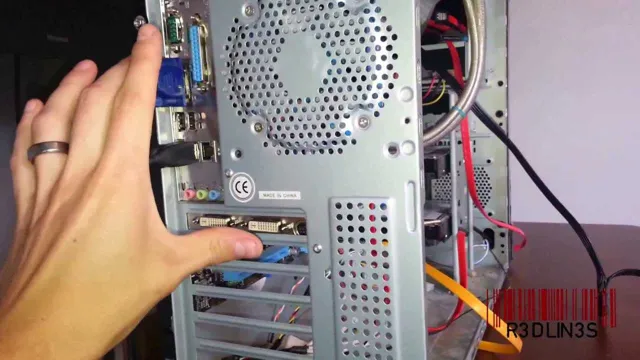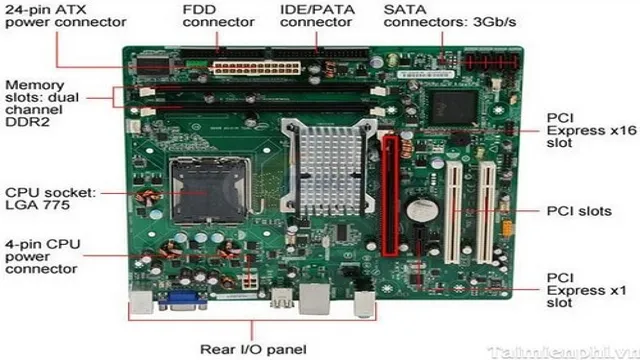Have you been noticing that your computer is not performing as well as it used to? Maybe you have tried to run a program or game and it just won’t load. You may have looked into it and realized that your onboard graphics card is not working. This can be a frustrating issue that can leave you feeling lost and uncertain about what to do next.
But don’t worry, we are here to help. In this blog, we will explore the reasons why your onboard graphics card may not be working and provide you with solutions to get your computer up and running smoothly again. Let’s dive in!
Diagnosing the Problem
Having an onboard graphics card not working can be a frustrating experience, but diagnosing the problem doesn’t need to be a daunting task. First and foremost, it’s important to check your computer’s manual or manufacturer’s website to ensure that your system is equipped with an onboard graphics card. If it is, then ensure that the graphics driver is up to date by navigating to the device manager, selecting the graphics card driver, and clicking the update driver button.
Additionally, you can try resetting your computer’s BIOS settings to default, as this can sometimes resolve issues with hardware configurations. If these steps don’t solve the problem, it’s possible that the onboard graphics card is malfunctioning, which may require professional repair or a replacement. With a bit of troubleshooting and persistence, you can get to the root of the issue and get your computer graphics back up and running smoothly.
Checking Device Manager
If you’re experiencing issues with your computer, one of the first things you should do is check your Device Manager. This tool allows you to see all of the devices that are connected to your computer, and can help you diagnose common problems such as driver issues and connectivity problems. To access the Device Manager on a Windows computer, simply right-click on the Start button and select “Device Manager” from the menu that appears.
From there, you can view all of your computer’s connected devices, and look for any warning symbols or error messages that indicate a problem. For example, if you’re having issues with your mouse not working properly, you may see a warning symbol next to the mouse device in Device Manager. This could indicate that the mouse driver is not installed or has become corrupted.
By right-clicking on the mouse device and selecting “Update Driver Software”, you can attempt to fix the problem by downloading and installing the latest driver from the manufacturer’s website. If the problem persists, you may need to replace the mouse altogether. Overall, the Device Manager is a useful tool for diagnosing a wide range of computer issues.
It can help you quickly identify problems with your devices and drivers, and take steps to resolve them before they cause further issues. So if you’re experiencing issues with your computer, be sure to check your Device Manager and see if any devices or drivers are causing the problem.

Running Hardware Diagnostics
When your computer starts to act up, it’s essential to run hardware diagnostics to diagnose the problem. This step helps determine if the issue is hardware-related or just a software glitch. Hardware diagnostics are usually available through the manufacturer or third-party diagnostic tools.
After initiating the diagnostics, the system will run checks on all the hardware components to identify any faults or failures. The results of the diagnostic test provide crucial information on which components have issues, and this information helps to isolate the source of the problem. Running hardware diagnostics is like taking your car in for a check-up, in that it identifies any underlying problems before they become more severe.
Overall, running hardware diagnostics is the first step in figuring out what’s wrong with your computer and getting it fixed to avoid bigger issues.
Possible Causes
If you’ve ever tried to use your computer’s onboard graphics card only to find that it’s not working, there are several reasons why this could be happening. Sometimes, the issue may be due to outdated or faulty drivers. In other cases, it could be a hardware issue like a loose connection or a damaged graphics card.
It’s also possible that your computer is overheating, causing the graphics card to malfunction. Additionally, if you’ve recently made changes to your computer’s hardware or software, this could be causing conflicts with your onboard graphics card. Finally, it’s possible that there’s an issue with your monitor or display settings.
If you’re not sure what’s causing the problem, it’s best to reach out to a professional for assistance in diagnosing and fixing the issue.
Driver Issues
Possible Causes of Driver Issues When it comes to computer-related issues, driver problems are among the most common. Drivers are software programs that enable your hardware and operating system to communicate. Without them, your computer won’t be able to recognize and use peripherals such as printers, keyboards, and mice, and your system may not function properly.
There are several possible causes of driver problems, including outdated, corrupt, or missing drivers, conflicting software, and hardware issues. Outdated drivers can cause compatibility problems with new software and operating systems, while corrupt or missing drivers can lead to system crashes and other issues. Conflicting software can also cause driver problems and may need to be removed or updated.
Hardware issues, such as damaged components or faulty connections, can also affect driver performance. By identifying the root cause of driver problems, you can take steps to fix them and prevent them from happening in the future.
Hardware Failure
Hardware failure is inevitable and can be caused by a variety of factors. One of the most common causes is overheating. Overheating can be caused by a lack of proper ventilation or cooling, outdated hardware, or even a power supply that’s no longer adequate for the components in use.
Another common cause of hardware failure is physical damage. This can range from accidental drops to wear and tear over time. Other possibilities include power surges, electrical shorts, and manufacturing defects.
In order to prevent hardware failure, it’s important to monitor temperatures, keep components clean and up-to-date, and invest in surge protectors and other protective measures. Even with proper precautions, however, hardware failure is always a possibility. When it does occur, it’s crucial to address the issue as soon as possible to avoid causing further damage to other components.
Compatibility Problems
Compatibility problems are common issues that users may encounter when trying to use different hardware or software components together. There are several possible causes of these problems that can range from outdated drivers to conflicting versions of software or even hardware incompatibility. For instance, when trying to install a new software application on an older operating system, this can lead to compatibility issues where the software may not function correctly or even fail to install altogether.
Additionally, different brands of hardware may also have compatibility problems when trying to integrate them with other components, especially when they are not designed to work together. In some cases, the issue may be due to a lack of compatibility testing during the design or development phase of a particular product. Therefore, it is essential to ensure that all components used in a system are compatible with each other to avoid any potential issues in the future.
Solutions
If you’re experiencing problems with your onboard graphics card, there are a few solutions to try before considering a hardware replacement. First, make sure that your operating system and drivers are up to date. Often, outdated software can cause conflicts that impair graphics card performance.
If that doesn’t work, check the BIOS settings to ensure that your onboard graphics card is enabled. Sometimes, it can be mistakenly turned off, leading to malfunctions. If that still doesn’t solve the issue, try resetting the CMOS.
This will reset any changes made to your BIOS settings and may resolve the problem. However, if none of these solutions work, you may need to contact your computer’s manufacturer or consider purchasing a new graphics card.
Updating Drivers
Updating drivers can be a frustrating and time-consuming task, but it’s also essential for maintaining optimal performance on your computer. Fortunately, there are many solutions available to simplify the process and get you back up and running in no time. One of the easiest ways to update drivers is to use the built-in software updater on your computer’s operating system.
This feature can automatically search for and install updates for all of your device drivers with just a few clicks. Alternatively, you can use third-party driver update software to scan your system for outdated or missing drivers and download the latest versions directly from the manufacturer’s website. Some popular options include Driver Booster, Driver Easy, and Snappy Driver Installer.
Whether you choose to use the built-in updater or a third-party solution, it’s important to regularly check for updates to ensure that your system is running smoothly. By keeping your drivers up-to-date, you’ll enjoy improved stability, compatibility, and performance, helping you get the most out of your computer.
Replacing the Card
Replacing a credit or debit card can be quite troublesome, especially if it’s lost or stolen. However, there are several solutions available that can ease the process. Firstly, it’s essential to immediately contact your bank or credit card company to report the loss or theft of your card.
They will cancel the old card and provide you with a new one that you should receive within a few business days. Many banks now offer the option of instant card replacement at selected branches where you can have a new card issued right away. Another solution is to use mobile wallet payment methods.
With mobile wallet apps, you can store your card details digitally and use your phone to make payments in-store or online, without needing to use your physical card. These solutions not only provide faster and more secure options for replacing a lost or stolen card, but they also offer more convenient ways to make payments.
Conclusion
In summary, having an onboard graphics card not working is like trying to drive a car with a flat tire – it won’t get you very far. It’s important to address the problem and potentially invest in a new graphics card to ensure smooth and efficient performance of your device. Remember, a stitch in time saves nine, and a functioning graphics card saves frustration and potential system crashes.
Happy computing!”
FAQs
What are some common reasons why an onboard graphics card may not be working?
Some common reasons why an onboard graphics card may not be working include driver issues, hardware problems, conflicts with other hardware components, and incorrect BIOS settings.
How can I troubleshoot an onboard graphics card that is not working?
You can troubleshoot an onboard graphics card that is not working by updating drivers, checking hardware connections, running hardware diagnostics, and adjusting BIOS settings.
Is it possible to use a computer without an onboard graphics card?
Yes, it is possible to use a computer without an onboard graphics card by using a discrete graphics card or by using a CPU with integrated graphics.
Can a faulty onboard graphics card damage other hardware components in my computer?
While it is unlikely that a faulty onboard graphics card will damage other hardware components in your computer, it is still possible in certain situations. It is best to troubleshoot and resolve any issues with your graphics card as soon as possible to avoid potential damage.
